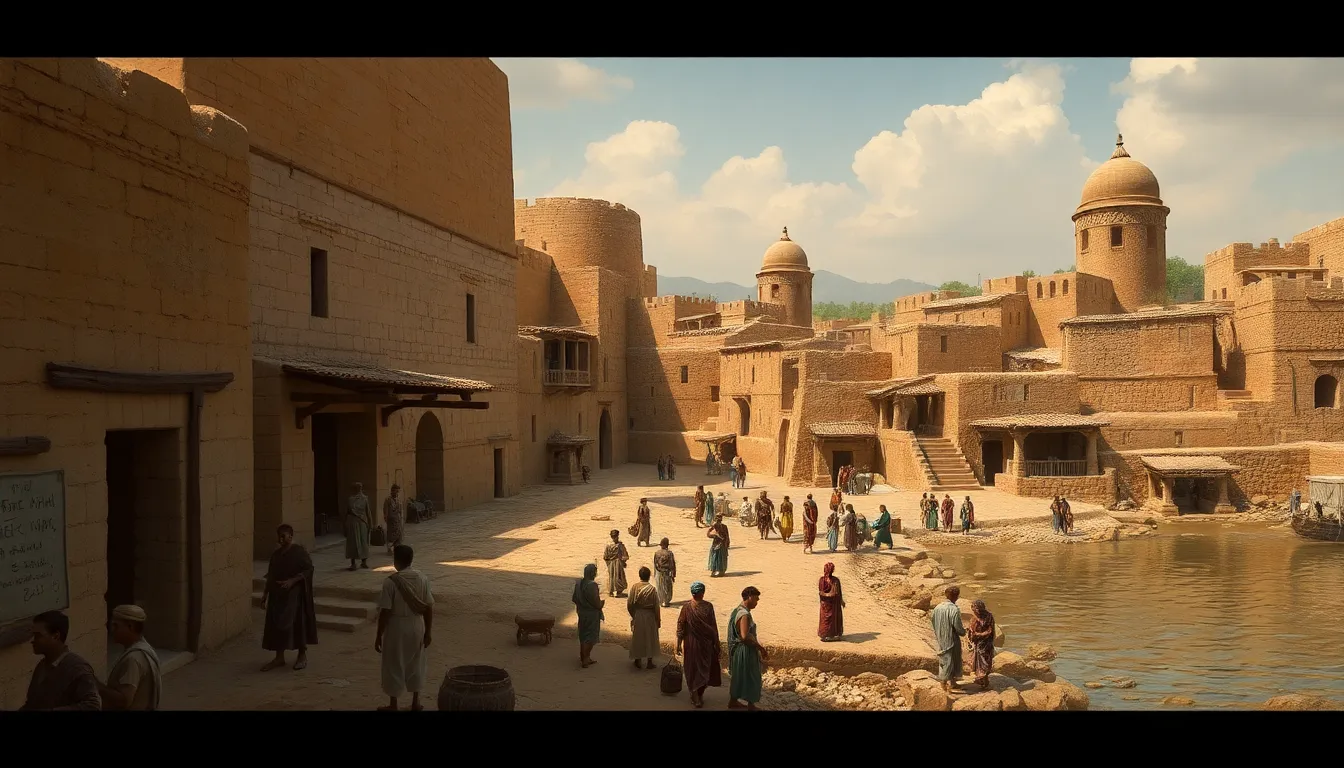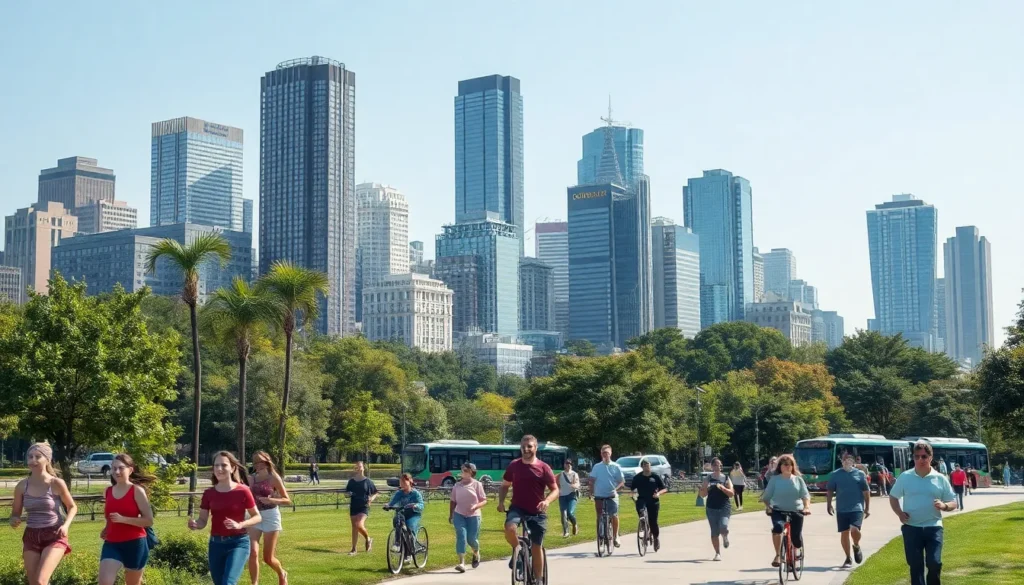Table of Contents
ToggleAs the global population continues to surge, urban development is more crucial than ever. Cities are evolving into vibrant hubs of culture, innovation, and economic activity, shaping the way people live and interact. This rapid transformation presents both exciting opportunities and significant challenges for urban planners, policymakers, and residents alike.
The dynamics of urban development encompass a range of factors, from sustainable architecture to transportation infrastructure. Understanding these elements is essential for creating livable spaces that meet the needs of diverse populations. As cities strive to balance growth with environmental sustainability, the future of urban living hangs in the balance, making it a topic worth exploring in depth.
Overview of World Urban Development
World urban development plays a pivotal role in shaping modern society. Over 55% of the global population resides in urban areas, with projections suggesting this figure will rise to 68% by 2050 (United Nations, 2022). This demographic shift drives cities to adapt and innovate. Urban development encompasses a range of components, including infrastructure, housing, and public services, all tailored to accommodate growing populations.
Urban centers serve as engines of economic growth. Cities generate approximately 80% of global GDP, underscoring their importance in fostering business and industry. Investment in urban infrastructure, including transportation and utilities, enhances connectivity and boosts productivity. Moreover, urban areas offer a diverse array of cultural and social experiences, promoting inclusivity and community engagement.
Sustainability remains a crucial consideration in urban planning. Urban developers increasingly focus on eco-friendly building practices and green spaces. This approach aims to mitigate environmental impacts while enhancing the quality of life for residents. For instance, initiatives such as tree planting and renewable energy integration exemplify efforts to create healthier urban environments.
Challenges persist, including inadequate housing and transportation congestion. Rapid urbanization can lead to informal settlements, presenting risks for vulnerable populations. Addressing these issues requires coordinated strategies among governments, private sectors, and communities. Effective urban development hinges on collaboration, innovative solutions, and sustainable practices that meet the demands of contemporary urban living.
Historical Context of Urban Development

Urban development has evolved significantly over centuries, driven by social, economic, and technological changes. Understanding this history offers insights into contemporary urban challenges and strategies.
Early Urbanization
Early urbanization began around 3,500 BCE with the establishment of cities in the Fertile Crescent, including Mesopotamia. These early cities, such as Uruk and Babylon, emerged around fertile land and river systems, facilitating agriculture and trade. Population growth led to the development of social hierarchies and specialized labor, enhancing cultural and economic interactions. By 1,000 BCE, urban centers spread across civilizations like Ancient Egypt, the Indus Valley, and the Maya, marking the importance of cities in shaping human societies.
Industrial Revolution Impact
The Industrial Revolution, from the late 18th to the mid-19th century, transformed urban development dramatically. It spurred mass migration to cities, with populations in urban areas expanding from 15% in 1800 to about 50% by 1900. Factories emerged, creating jobs and attracting workers, while advancements in transportation, such as railways, further facilitated urbanization. This rapid growth resulted in overcrowded living conditions, often leading to the rise of slums. Urban planning, as a discipline, began to emerge during this period in response to these challenges, emphasizing the need for organized infrastructure and public health improvements, shaping how modern cities developed.
Current Trends in Urban Development
Urban development trends reflect the changing dynamics of cities as populations grow and evolve. Understanding these trends is crucial for creating effective urban strategies and addressing the challenges that arise.
Global Urbanization Rates
As of 2020, around 55% of the global population lived in urban areas, with projections indicating this figure could rise to 68% by 2050. This urbanization trend presents significant implications, particularly in developing regions, where urban populations are expected to increase by approximately 1.5 billion people. Significant urban centers, especially in Asia and Africa, are witnessing rapid growth, leading to the need for enhanced infrastructure, public services, and housing solutions to accommodate diverse communities.
Sustainable Urban Development Practices
Sustainable urban development practices focus on minimizing environmental impact while promoting quality of life. Strategies include:
- Green Building Initiatives: Many cities adopt eco-friendly design practices, utilizing sustainable materials and technologies that reduce energy consumption and carbon footprints.
- Transport Management: Integrated public transport systems, such as buses and subways, encourage reduced reliance on personal vehicles, lowering congestion and emissions.
- Urban Green Spaces: Cities increasingly prioritize parks and green corridors to enhance biodiversity, improve air quality, and provide recreational areas for residents.
- Mixed-Use Developments: Projects that combine residential, commercial, and recreational spaces foster community interaction and reduce the need for long commutes, promoting a sense of locality.
These sustainable practices aim to create resilient urban environments capable of adapting to the ecological and social challenges of modern life.
Challenges in World Urban Development
Urban development faces numerous challenges, including economic disparities and environmental concerns. These issues hinder the progress of efficient, inclusive, and sustainable urban growth.
Economic Disparities
Economic disparities significantly affect urban development. Income inequality leads to uneven access to resources, public services, and opportunities. For instance, affluent neighborhoods often receive better infrastructure and amenities, while low-income areas struggle with inadequate housing, limited transportation options, and lack of public services.
Data shows that urban poverty affects approximately 1 billion people globally, with informal settlements representing over 30% of urban populations in developing countries. Access to quality education, healthcare, and employment opportunities remains critical for bridging this economic gap. Urban planners must incorporate inclusive policies and targeted investments to ensure equitable access to necessary resources for all residents.
Environmental Concerns
Environmental concerns pose a major challenge in urban development. Rapid urbanization accelerates pollution, waste generation, and depletion of natural resources. Urban areas contribute to around 70% of global greenhouse gas emissions, intensifying the effects of climate change.
Water scarcity affects nearly 2 billion people, mainly in cities where overuse and contamination threaten supplies. Additionally, biodiversity loss due to habitat destruction limits ecosystem services essential for urban resilience. Urban planners must adopt sustainable practices, such as green infrastructure and waste management systems, to mitigate these issues, promoting ecological health while catering to growing urban populations.
Future of World Urban Development
The future of urban development hinges on innovative solutions to meet the challenges posed by rapid population growth and environmental concerns. Emerging technologies and strategic policies drive this transformation.
Smart Cities and Technology
Smart city initiatives leverage technology to enhance urban living. These cities utilize data analytics and the Internet of Things (IoT) to optimize services and infrastructure. Traffic management systems reduce congestion by monitoring real-time conditions, while smart grids enhance energy efficiency through responsive power distribution. Examples include Barcelona’s smart lighting, saving energy while improving safety, and Singapore’s intelligent transport systems, which streamline public transit.
Additionally, technology supports sustainable practices via green buildings that utilize energy-efficient designs and renewable materials. Urban farming initiatives, supported by vertical gardens and hydroponics, contribute to food sustainability directly within city limits. Integration of technology in urban planning empowers cities to adapt to changing demographics and environmental conditions while ensuring a high quality of life for residents.
Policy Recommendations
Effective policies are crucial for fostering sustainable urban development. Governments should prioritize inclusive zoning laws that encourage affordable housing and mixed-use developments. These policies promote diverse communities and prevent socioeconomic segregation. Implementing transit-oriented development enhances accessibility to public transportation, reducing reliance on personal vehicles.
Investment in green infrastructure is imperative for mitigating environmental impacts. Policies must support the development of urban green spaces, parks, and green roofs, which improve air quality and biodiversity. Collaborative efforts between public and private sectors can lead to financing mechanisms that incentivize sustainable practices and innovations.
Lastly, integrating community feedback into urban planning ensures that developments meet the needs of local populations. Engaging residents in decision-making processes fosters a sense of ownership and leads to more resilient urban environments.
Urban development stands at a crossroads as cities face unprecedented growth and environmental challenges. The shift towards sustainable practices is essential for creating livable spaces that accommodate diverse populations. Innovations like smart city initiatives and green infrastructure can pave the way for more resilient urban environments.
Collaboration among governments, businesses, and communities will be vital in addressing issues like economic disparity and environmental degradation. By prioritizing inclusive policies and community engagement, cities can evolve into vibrant hubs that not only support economic growth but also enhance the quality of life for all residents. The future of urban living hinges on this balance, ensuring cities thrive amid rapid change.




